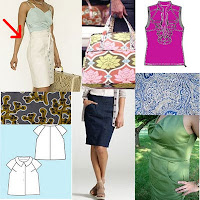 Once I got serious about this project, I found myself faced with a dilemma--to buy the "Beignet" pattern, or to draft my own. Colette Patterns is a small, independent pattern company, and Beignet, like all its patterns, is the original design of the company's founder, Sarai Mitnick. I try to support these sorts of businesses whenever I can, and I've heard glowingly positive things about Colette Patterns in particular. Their designs are distinctive, their patterns are well-drafted and high-quality, and their instructions are clear and complete.
Once I got serious about this project, I found myself faced with a dilemma--to buy the "Beignet" pattern, or to draft my own. Colette Patterns is a small, independent pattern company, and Beignet, like all its patterns, is the original design of the company's founder, Sarai Mitnick. I try to support these sorts of businesses whenever I can, and I've heard glowingly positive things about Colette Patterns in particular. Their designs are distinctive, their patterns are well-drafted and high-quality, and their instructions are clear and complete.That said, Beignet is a very simple skirt to draft. That's not to take anything away from it's design, which is original and compelling. But structurally speaking, once you've seen it, it's pretty clear how one would draft it. In fact, it seemed to me that altering the skirt to fit my proportions would potentially take just as much time, and yield less consistent results, than simply drafting it from scratch based on my personal sloper. In the end, that's what I decided to do, but I'm still pretty conflicted about the decision. So, I'm writing up the project on this blog, but only with several statements by way of a disclaimer:

1. "Beignet" is Sarai's original design. She deserves all credit for this classic, flattering and versatile skirt.
2. Although I drafted my own version of this skirt, I won't talk about that process here. I'll stick to discussions of the construction process and how the skirt fits into the planning of my Up North wardrobe.
3. If you like the look of this project, you should absolutely, positively buy a "Beignet" pattern from Colette Patterns!
Ok, now that I've got that all cleared up, here's an update on how the project has been going so far. Frankly, it's been a slog. I've got no sewing momentum right now, but I'm trying to make progress, since I have one or two more projects in my queue that are definitely for summer, and won't transition well into fall. (This skirt is one, and my magenta ruffle-front blouse is another.)
I'm also not totally thrilled with my fabric choice for this project. The fabric I picked is a stretch bottom-weight, but it's semi-sheer even with the lining, and you can definitely see the interfacing and the seam allowances (and sometimes, my underwear!) through from the outside. I've also made one or two dubious construction decisions that I find myself second-guessing, and I'm dreading making all 12 buttonholes on the front.
What's more, I'm changing size right now in all sorts of weird ways (marathon training is at least partly to blame), so I keep making fitting alterations on the fly. I'm already sewing at the tail end of the season, and while I'd usually be o.k. with stashing a project like this in my closet for a year, I'm not at all confident that this skirt will fit me next summer.
 So I'm trying to soldier through and finish the skirt soon, hoping to get at least a few wearings out of it this year. But given my frustrations with my fabric, I'm seriously reconsidering the summer jacket I had planned to make from the leftover piece. On the one hand, a wardrobe doesn't really seem complete without some sort of "topper." But on the other hand, it might not be worth the grief of working with this fabric. Would a jacket like this look terrible if the darts & seam allowances showed through a bit? Should I give it a stab, or run screaming? What do you think?
So I'm trying to soldier through and finish the skirt soon, hoping to get at least a few wearings out of it this year. But given my frustrations with my fabric, I'm seriously reconsidering the summer jacket I had planned to make from the leftover piece. On the one hand, a wardrobe doesn't really seem complete without some sort of "topper." But on the other hand, it might not be worth the grief of working with this fabric. Would a jacket like this look terrible if the darts & seam allowances showed through a bit? Should I give it a stab, or run screaming? What do you think?









